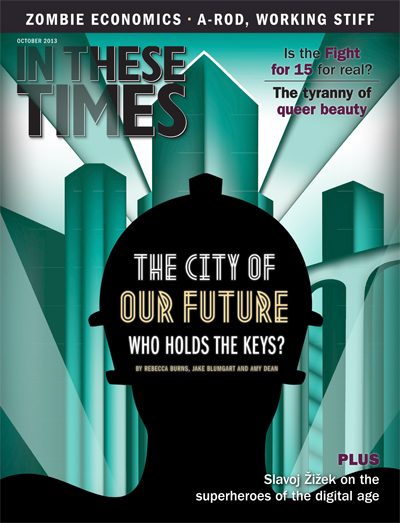A Union-Remade City
Labor is taking back New Haven. But can it put people back to work?
Jake Blumgart

It’s a beautiful Sunday in late August, and in New Haven’s Newhallville neighborhood, people are out on their porches. Alderwoman Delphine Clyburn seems to know each of them — an advantage for a politician running for re-election. She is out knocking on doors two years after winning office as part of a slate of 20 labor-backed candidates for the New Haven city council (known as the Board of Aldermen), the vast majority of whom are newcomers like Clyburn.
“A lot of people didn’t know me when I first ran,” says Clyburn of the passersby who greet her as she walks the neighborhood. “Now it’s like family.” She can recall details about those who live in almost every house she approaches: “Her sister passed not too long ago. … He’s a plumber, his wife runs a day care.”
The labor-backed slate forced out many of Democratic Mayor John DeStefano’s allies, ending his unilateral 20-year reign over New Haven politics, which critics considered typical of the city’s insular and ossified urban machine. In 2013 he decided against seeking an 11th term. So Clyburn is also stumping for Toni Harp, a longtime state senator, for mayor. Harp’s signs festoon the neighborhood, which is lower-income and predominantly African-American. Harp is supported by the Yale unions, UNITE HERE Locals 34 and 35, which provided the funds and organizing acumen that made the 2011 victories possible. (The Connecticut Center for a New Economy, a labor-funded think tank and advocacy group, is also an important force in town — but does not take direct action in elections.)
In addition to the union support, a number of factors were at work in New Haven that allowed for the 2011 takeover. The 30-seat city council is large for a municipal legislative body. Each ward contains only 4,000-some constituents, so with a concerted effort it’s possible to knock over an entrenched incumbent. New Haven also has a private-sector labor movement unmatched elsewhere in Connecticut, which provided the leverage needed to open up the once-closed world of New Haven politics.
Door-to-door democracy
Previously, the fragmented Board of Aldermen provided an ineffective counterweight to the mayor. Now, the 2011 slate is able to form enough of a majority on most issues to set its own policy agenda. And that agenda is based on the chief concerns that were expressed by neighborhood residents when the candidates went from house to house during their campaigns. “We got our priorities for the city off of the doors, talking to thousands of people in the city and finding out what they cared about,” says Tyisha Walker, alderwoman for Ward 23. Jobs, youth and public safety, crime and violence topped the list, she said.
Few clear-cut policy successes of the 2011 electoral victory are evident yet, although the police department’s sudden shift toward a more community oriented strategy—more police walking a beat and fewer cruising around in cars—was championed by the labor-backed candidates during an election year with a record-high murder rate. The mayor instituted the change in 2011, just after the electoral victory but before the aldermen took office.
From the jobs agenda emerged perhaps the most ambitious city council project. New Haven has an official unemployment rate of 11.3 percent (and if those who have stopped looking for work or settled for part-time employment were counted, that figure would be much higher). Numerous job training programs exist at both the state and city level, but these often fail to connect trainees with jobs.
“[We thought] we don’t need another training program, we need case management and a better way to coordinate [between job seekers and companies],” says Jorge Perez, a 26-year veteran alderman and president of the board. “Let’s pass a law that says if you get any kind of help from the city, you have to hire residents. That doesn’t work too well in many cases because people find ways around it, or worse yet, we can’t provide qualified, trained people. Putting a gun to someone’s head doesn’t work.”
So the board formed New Haven Works, a non-profit collaboration between the Board of Aldermen, the Yale unions and the city’s big employers.
New Haven Works opened its doors in June and, after public grant money starts flowing in October, 50 percent of its budget will be covered by the state and the city, 25 percent by Yale, 16 percent by the unions, and the rest by funding from private foundations and employers. Job seekers meet with a New Haven Works staffer to determine their skills and education. If they need more training, they are referred to a relevant program; if not, New Haven Works tries to match them with suitable open positions. Should they fail to get the job, the organization follows up with the employers to find out why.
New Haven Works’ orientation sessions, which began in March, have been attended by 1,000 people, and so far 60 applicants have been placed in jobs with seven different employers: Yale University, the City of New Haven, the New Haven Parking Authority, New Haven Works itself (which is required to hire city residents), Start Community Bank, the Yale-New Haven Hospital (a distinct entity from the university), and the Quinnipiac Polling Institute. New Haven Works is trying to match another 300 people who have completed the process with 200 jobs that are accepting applicants.
Each of the 60 jobs New Haven Works has secured so far pays above the Connecticut minimum wage of $8.25, and all but six pay more than $10 an hour. When Quinnipiac first requested candidates from New Haven Works, the institute only offered 20 hours a week of night work at $9.50 an hour, with no benefits. New Haven Works told Quinnipiac that it could be difficult to find workers for such low pay, especially as the public buses stop running before the end of the evening shift. A few weeks later, Quinnipiac raised the minimum pay of all current employees and all new hires to $10.50. To get around the transportation issue, New Haven Works is researching the cost of subsidizing a shuttle for employees hired through the non-profit.
“It’s baby steps. We need more people to buy in,” says Brian Wingate, alderman for Ward 29, who beat the then president of the board of aldermen in 2011. “But I believe we will. People have gotten jobs. There’s a value in just giving people opportunities to get jobs, live here, stay here.”
Government for the people
With New Haven Works, the labor-backed aldermen offer an example of how municipal governance can work in an age of austerity: by conducting close constituent service, brokering partnerships among private, non-profit and public entities, and securing funding from state and local power players. But getting the effort off the ground has depended on help from both powerful private-sector unions and the wealth of an Ivy League university (which have split the bulk of the start-up costs). Few other communities have either of those pillars, let alone both.
Currently, New Haven Works is holding talks with regional utilities, manufacturing firms and construction companies to expand its reach. But outside Yale or public-sector employment, it is an open question how many available positions will be permanent or full-time. On other issues, like the long decline of New Haven’s community centers and youth programming, progress is halting. Money has been secured for feasibility studies and some renovations of fields and facilities, but complications have arisen in almost every case—from hazardous materials found in Bowen Field, an athletic space, to the large price tags attached to fixing up a community center called Q House, which in 2003 was shuttered after 75 years of service.
When it comes to education, the current board of aldermen hasn’t crafted a comprehensive strategy. But a 2012 deal with the non-profit charter school organization Achievement First, crafted by Clyburn and fellow first-year Alderwoman Brenda Foskey-Cyrus, may provide a hint of things to come. The two alderwomen allowed Achievement First to open a new charter school on the grounds of an abandoned public school building after management signed a Community Benefits Agreement. The compact commits Achievement First to admitting 10 neighborhood kids to the freshmen class who hadn’t previously attended an Achievement First school; giving neighborhood residents uninhibited access to athletic areas; donating $150,000 to local youth programs; working to provide cafeteria, custodial and security jobs to neighborhood residents; and making a serious effort to hire black and Latino teachers. Clyburn hails the agreement as a success: It’s one of the chief talking points in her re-election campaign.
The lack of dramatic victories is to be expected from a two-year term in a resource-strapped city, says Paul Bass, editor of the New Haven Independent, a non-profit news website. “When you’re new it takes time to actually implement policy and figure out where the bodies are buried. They are still learning and it’s too early to see results. They are still trying to figure out how to run a city.”
Redistributing resources
At the end of its first term, New Haven’s labor-backed Board of Aldermen is about to shed the last of DeStefano’s machine — the mayor himself. But its future, and New Haven’s, is inexorably tied to larger forces. Progressive initiatives depend upon the ability of government to redistribute resources, which in turn requires a pool of available funds. That’s a role most municipalities, including New Haven, are ill-suited to play.
New Haven’s home state is one of the richest in the country, but it has profoundly poor urban areas. Four of Connecticut’s five largest cities—New Haven, Hartford, Bridgeport and Waterbury—have poverty rates of more than 20 percent and unemployment rates higher than 10 percent. All four are former manufacturing centers that experienced a uniform fate: capital flight, weak labor markets, high property taxes and chronic budget woes.
In this context, local politicians, no matter how progressive, are forced to act as managers of austerity. In New Haven, multiple concessionary contracts with municipal workers have been negotiated since the labor slate’s election — including with city clerical workers and custodians, many of whom were laid off. The school system continues to struggle, and the city faces budget deficits.
“No matter what you get out of Yale or City Hall, New Haven doesn’t have the resources to address the long-term, endemic social-justice issues,” says Ben Healey, a former New Haven alderman who went on to work with the New York Working Families Party in Massachusetts and elsewhere. “I’m very hopeful that you can build these [movements] at the municipal level. What I have yet to see in Connecticut or elsewhere is building them at a statewide level. The resources you need to make change are in states, but it’s that shift up a level that’s been hard.”
Democratic Gov. Dannel Malloy’s initial proposed 2013 budget would have substantially downsized municipal aid, losing New Haven an estimated $13.8 million (by DeStefano’s estimate). Although the final budget restored much of this funding, it’s a reminder of just how dependent revenue-limited cities are upon outside help. And a reminder that the biggest challenge facing Clyburn, Walker, Wingate and their aldermanic colleagues won’t be found in this year’s municipal elections, but in the torturous decisions facing a city with a dwindling rainy day fund, falling credit ratings and a looming pension crisis.








